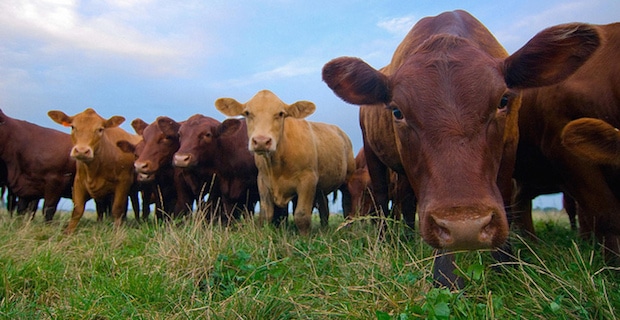
The factory farming of livestock in the U.S. and Canada can be hard to stomach. The inhumane, almost brutal living conditions along with the antibiotics, hormones, and pesticide-laden feed animals are often force fed is upsetting. While I’m not a vegetarian, nor is my family, we’ve dramatically cut back on the amount of meat we consume, and when we do eat meat at home, we choose organic options. I used to consume animal protein three times a day, but cut back to only once a day. I generally have it at dinner.
As I became more knowledgeable about GMOs, I started to educate myself on the different options available for meat consumption. All-natural, antibiotic-free, hormone-free, grass-fed, etc. However, unless meat is organic, then the feed animals are given most likely contain GMOs, like corn and soy. Even if a product states it is antibiotic and hormone-free, it can still contain GMOs.
Want to consider giving up meat? Read more on why to go vegan
Similar to the term “natural” the term “grass fed” has become a buzzword that defines the health food movement. Unlike the term natural, grass fed actually means something but it can be super confusing. Here’s a closer look at grass fed:
What is Grass Fed?
- The USDA grass fed standard requires that animals must have continuous access to pasture during the growing season, although animals do not have to spend their entire life at pasture.
- Forage must be their food source for the duration of their life after weaning. Animals can’t be fed grain or grain products.
- Hay, crop residue without grain, and cereal grain crops in their pre-grain stage are also acceptable feed.
Problems with Grass Fed
- While the USDA says that sheep, cattle, goats, and bison must pasture during growing season, growing season isn’t defined so there may be some level of confinement.
- Smaller farmers tend to consider “pasture-raised” the best term to describe animals raised outdoors.
- Grass fed animals can still be given hormones and antibiotics so do not assume they are free of either of these unless it is stated on the label.
A Better Grass Fed
The American Grassfed Association has developed more stringent standards for their definition of grass fed which says that animals may not be confined in a pin, feedlot, or other area. Antibiotic and synthetic hormones are also prohibited under their certification label. This would be the label I would look for to ensure you are getting the real "grass fed" deal.
Read more about factory farming meat
Understanding where and how the animals you are eating were raised, and how they were treated during their lifetime, and at the time of slaughtering, is important for many reasons, including the hormones (like cortisol) that are released into their system just prior to their death (which we end up eating ourselves).
At my local health food store the butcher says their grass fed beef is "grain finished." Since by legal definition grass fed animals need to be grass finished, the use of the "grass fed, grain finished" terminology is confusing and misleading. It is a marketing term used to lead consumers to believe they are buying a superior product, when in the end, it is not much different from the other grain fed products which were potentially fed GMOs (the reason animals are grain finished is to fatten them up because grass fed animals are leaner). So if you're looking for 100% grass fed beef, then look for the American Grassfed Association label mentioned above.
Here is an excellent PDF from the American Grassfed Association of all the meat terms. I urge you to read it before your next shopping trip: Meat Primer Tip Sheet.
If you have questions about reading meat labels, feel free to leave them in the comments below.




